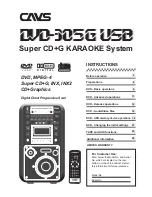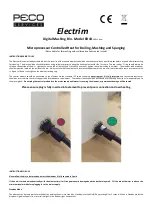
6.
Compressed gas cylinders
are potentially dangerous. Consult the supplier
for correct handling procedures. Always protect
compressed gas cylinders from the sun’s rays,
flames and sudden temperature changes.
1.3 FIRE AND EXPLOSION PREVENTION
Hot slag and sparks can
cause fire. The risk of fire and explosion can
be minimized by removing all flammable mate-
rial from the welding area.
1.
Always perform welding operation with caution.
Containers and tubes that have been emptied
and thoroughly cleaned still represent a poten-
tial hazard.
2
. As a preventative measure, keep fire extin-
guishers near the welding operation.
3
. Never perform welding operations or cut a
closed container or pipe.
4
. Never perform welding operations on open con-
tainers or pipes that may have been contami-
nated with substances that could explode or
react when exposed to heat or humidity.
1.4 METAL FUME HAZARDS
Welding fumes and gases may be
hazardous if inhaled.
1.
Install a ventilation system in the welding area.
2
. Use a forced air system when welding lead,
beryllium, cadmium, zinc, zinc-coated or paint-
ed material. Always wear a protective mask.
3
. If the ventilation system is inadequate, use an
air respirator.
4. Beware of gas leaks. Shielding gases such as
argon are heavier than air and when used in
small spaces, will replace the air.
5
. In the event that a welding operation occurs in
a confined place, the operator should be
accompanied by another person.
6
. Always keep gas cylinders in a well-ventilated
area. Close the main gas valve when cylinder
is not in use.
7
. Do not perform welding operations near chlori-
nated hydrocarbon vapors produced by
degreasing or painting. The heat generated by
arc rays can react to form phosgene, a highly
toxic gas.
8
. Irritation of the eyes, nose and throat are symp-
toms of inadequate ventilation. Take immediate
steps to improve ventilation. Do not continue
welding if symptoms persist.
1.5 TRANSPORTING THE POWER
SOURCE
The welding machine may be carried by the
handle.
1.
Always disconnect the power source and
accessories from the main supply before lifting
or handling the welding equipment.
2
. Do not drag, pull or lift welding equipment by
the weld cables.
1.6 MAGNETIC FIELDS CAN AFFECT
PACEMAKERS
1.
Keep pacemaker wearers away from
welding operations.
2
. Pacemaker wearers should consult with a
physician prior to being exposed to any welding
or cutting operation.
1.7 H.F. RADIATION CAN CAUSE INJURY
1.
High frequency (HF) emissions can
interfere with radio navigation, safety devices,
computers and communication equipment.
2.
Installation of welding equipment should be
4
Содержание M 132
Страница 9: ...INSTALLING WELDING GUN TURN OFF WELDER BEFORE MAKING CONNECTIONS 9 1 4 2 3 ...
Страница 22: ...1 4 2 3 22 INSTALLATION DE LA TORCHE DE SOUDAGE ÉTEINDRE LE POSTE AVANT DE PROCÉDER AUX CONNEXIONS ...
Страница 34: ...1 4 2 3 34 INSTALACIÓN APAGUE LA SOLDADORA ANTES DE REALIZAR CONEXIONES ...
Страница 39: ... ...
Страница 42: ...42 ELECTRICAL DIAGRAM SCHÉMA ÉLECTRIQUE DIAGRAMA ELÉCTRICO M 132 ...
Страница 43: ...43 ELECTRICAL DIAGRAM SCHÉMA ÉLECTRIQUE DIAGRAMA ELÉCTRICO M 172 ...
Страница 44: ...44 SPARE PARTS LIST PIECES DETACHEES LISTA PIEZAS DE RICAMBIO M 132 ...
Страница 46: ...46 SPARE PARTS LIST PIECES DETACHEES LISTA PIEZAS DE RICAMBIO M 172 ...
Страница 49: ...49 ...





































